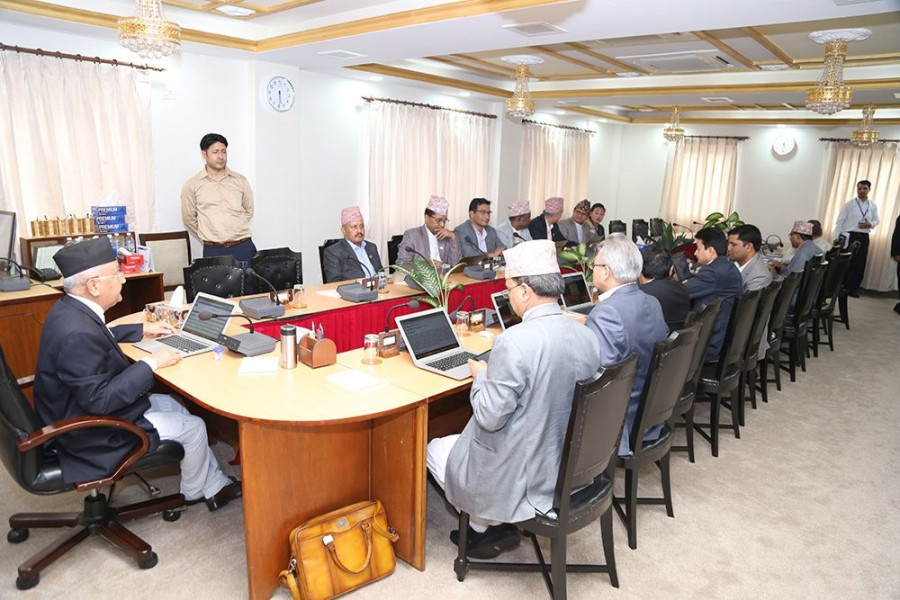National
Increasing number of ministries to pacify dissidents sets poor precedent, experts say
It would not only go against the spirit of the constitution but also federalism and provincial governments could follow suit in future exercising their constitutional right, they say.
Binod Ghimire
The hullabaloo in the Nepal Communist Party has died down after many months.
No more is there a clamour for the resignation of Prime Minister KP Sharma Oli. The warring factions called a truce after an agreement that the Cabinet would be reshuffled and the honchos would get their men ministerial berths.
But too many want to be ministers. The solution: break up some ministries.
There are 22 ministries now.
Prime Minister Oli is in discussions with the other chair Pushpa Kamal Dahal to divide three ministries, according to party insiders.
Increasing the number of ministerial portfolios gives more room to address the dissenting voices in the party.
Article 76 of the Constitution of Nepal limits the number of ministers to 25.
“Increasing the number of ministries will not just harm the country but also the incumbent government and the ruling party,” said senior advocate Chandra Kanta Gyawali, who specialises on constitutional law.
Governments in the past are well known to have formed jumbo Cabinets to pacify different coalition partners and give them ministerial berths. Since the second government was formed in the multi-party democracy era in 1994, Nepal has never had a government with a majority.
That is until the incumbent one.
Political analysts say though the country witnessed a huge political transformation, the mindset of the parties hasn’t changed.
“It is unfortunate that the party commanding a near two-thirds majority is splitting ministries against the spirit of the constitution,” Hari Roka, who writes political commentaries in Kantipur daily, the Post’s sister publication, told the Post.
“This happens when there is no political culture.”
Even the present limit of 25 ministries is too high, some experts say.
“Numbers of ministries and departments are already more than enough. They need reduction, not increment,” said Dilli Raj Khanal, an economist who headed the Public Expenditure Review Commission.
In its report submitted to the government in February last year, it had suggested limiting the number of ministries to 16.
The commission formed, ironically, by the Oli government in August 2018, had given two reasons for slashing the number of ministries. First, because the workload of the federal government had gone down significantly with two other tiers of government at the provincial and local levels taking many of the functions of the earlier unitary state system and, second, to reduce the state expenditure.
“The move will also curtail the role of the provincial and local governments, which will ultimately weaken federalism,” said Khim Lal Devkota, an expert on fiscal federalism and local government.
According to a study by Devkota, the constitution has delegated around 60 percent of the functions of the state to the provincial and local governments.
“The NCP and the government seem to be going into reverse gear,” Gyawali told the Post. “Being the first government after the general elections based on the new constitution of Nepal, it has a responsibility to set a positive precedent in the implementation of the constitution.”
While the constitution was being drafted, experts had even suggested bringing down the number of ministries to 12.
In 2014, the Administrative Reform Recommendation Committee led by Kashi Raj Dahal, former chairperson of the Administrative Court, had suggested limiting the number of federal ministries to 12 once the country embraced the federal set-up. In the report submitted to then Sushil Koirala government in April 2014, the Dahal-led panel had suggested having 18 ministries until the general elections after the promulgation of the new constitution and reducing them to 12 once the local and provincial governments come into operation.
The recommendation of the Dahal-led panel was never followed. There was a competition among the successive governments in increasing the Cabinet size before the 2017 general elections.
In 2017, then Prime Minister Sher Bahadur Deuba had in fact broken his own two-decade-long previous record of 48-member Cabinet with a 50-member council to appease supporters within his party and the Pushpa Kamal Dahal-led coalition partner Communist Party of Nepal (Maoist Centre).
Prime Minister Oli too had come under fire in 2015 from within his own party when overnight during his first prime ministerial stint he had taken the number of ministers to 40 from 30. In the history of Nepal’s governments, that was the third largest Cabinet ever.
But in the current context, Khanal says increasing the number of the ministries is wrong. “Increasing the number of ministries is wrong both in terms of the spirit of federalism and the economic viability,” he told the Post.
Khanal said the very spirit of federalism is to slash the power at the centre and pass it down to the provinces and local governments so that “Singha Durbar” actually reaches the door steps of the people.
“Increasing the number of the ministries when the constitution has decreased the workload is an attack on the spirit of the constitution,” said Devkota. “Any move that lacks justification is done with bad intentions and increasing the number of ministries would be one of them.”
There is a further danger of increasing the size of the Cabinet.
The federal government is setting a wrong precedent which the provincial government could copy in the name of power-sharing, according to Devkota.
Article 168 (9) of the constitution says the State Council of Ministers can have a maximum of 20 percent of the total numbers of provincial assembly members. The Bagmati Province with 110 assembly members has seven ministers at present. It can have upto 22 ministers if it goes by the constitutional authority.
“It is now up to the federal government, the kind of example it wants to set,” he told the Post.




 8.12°C Kathmandu
8.12°C Kathmandu















